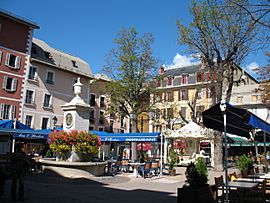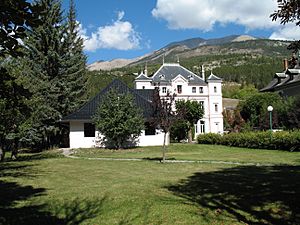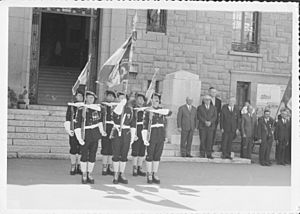Barcelonnette facts for kids
Quick facts for kids
Barcelonnette
|
||
|---|---|---|
|
Subprefecture and commune
|
||

Place Manuel
|
||
|
||
| Country | France | |
| Region | Provence-Alpes-Côte d'Azur | |
| Department | Alpes-de-Haute-Provence | |
| Arrondissement | Barcelonnette | |
| Canton | Barcelonnette | |
| Area
1
|
16.42 km2 (6.34 sq mi) | |
| Time zone | UTC+01:00 (CET) | |
| • Summer (DST) | UTC+02:00 (CEST) | |
| INSEE/Postal code |
04019 /04400
|
|
| Elevation | 1,115–2,680 m (3,658–8,793 ft) (avg. 1,132 m or 3,714 ft) |
|
| 1 French Land Register data, which excludes lakes, ponds, glaciers > 1 km2 (0.386 sq mi or 247 acres) and river estuaries. | ||
Barcelonnette is a town in France. It is located in the Alpes-de-Haute-Provence area, which is part of the Provence-Alpes-Côte d'Azur region. This town is nestled in the southern French Alps. It sits where the regions of Provence, Piedmont, and the Dauphiné meet. Barcelonnette is the biggest town in the Ubaye Valley. People from Barcelonnette are called Barcelonnettes.
Contents
- What's in a Name? The Story of Barcelonnette's Name
- A Look Back: The History of Barcelonnette
- Where is Barcelonnette? Geography and Nature
- Buildings and Design: Architecture in Barcelonnette
- How Many People Live Here? Population of Barcelonnette
- What Does Barcelonnette Do? Economy
- Learning in Barcelonnette: Education
- Getting Around: Transportation
- Friends Around the World: International Links
- Famous People from Barcelonnette
- Images for kids
- See also
What's in a Name? The Story of Barcelonnette's Name
Barcelonnette was officially started and named in 1231. This was done by Ramon Berenguer IV, who was the Count of Provence. Many people think the name is a smaller version of Barcelona in Catalonia, Spain.
However, some experts like Albert Dauzat and Charles Rostaing found an older name, Barcilona, used around 1200. They believe the name comes from two old words meaning "mountain": *bar and *cin. You can also see *cin in the name of Mont Cenis.
In the local Occitan dialect, the town is called Barcilona de Provença. Sometimes it's called Barciloneta. The old Latin name for the town was Barcino Nova, which means "new Barcelona". The Roman name for Barcelona was Barcino before it changed in the Middle Ages.
A Look Back: The History of Barcelonnette
Ancient Times: Early Settlers and Roman Rule
The area around Barcelonnette was first home to people called Ligures over 3,000 years ago. Later, the Celts arrived, and these two groups mixed to form the Celto-Ligurian people, known as the Vesubians. Ancient writers described the Vesubians as brave and good at trading.
After the Romans took over Provence, Barcelonnette became part of a small Roman province. Around 36 AD, the Roman Emperor Tiberius moved Barcelonnette to another province called the Cottian Alps. Under the Roman Empire, the town was called Rigomagensium.
Medieval Period: Founding and Changing Hands
The town of Barcelonnette was officially founded in 1231 by Ramon Berenguer IV, the Count of Provence. He gave the town special rights, allowing it to govern and defend itself starting in 1240.
During the Middle Ages, control of the area often switched between the Counts of Savoy and the Counts of Provence. It went back and forth many times. By the early 1500s, the area was mostly under Savoy's control. Eventually, the County of Provence joined the Kingdom of France.
Old Regime: Wars and Changes
In 1536, during an invasion by Charles V, the French king Francis I of France ordered the area to be burned so the invaders couldn't use its resources. Barcelonnette stayed under French rule until 1559.
Later, in 1588, troops led by François, Duke of Lesdiguières attacked the town, burning the church and a convent. Conflicts continued with Savoy, and Barcelonnette was captured and recaptured several times. In 1628, the town was looted and burned again during a war. It was also captured in 1691.
From 1614 to 1713, Barcelonnette was an important administrative center. The town's people even bought the right to govern themselves. In 1646, a school was started in Barcelonnette.
Many people in the town became Protestants in the 1500s. They faced difficulties during the French Wars of Religion. In 1713, Barcelonnette officially became part of France again.
The French Revolution and Beyond
Before the French Revolution, Barcelonnette had two Masonic Lodges. In March 1789, there were riots because of a shortage of wheat. In July 1789, news of the storming of the Bastille reached Barcelonnette, causing more unrest.
The town continued to experience protests and food shortages. A local patriotic group was formed in 1792. Barcelonnette was an important administrative district from 1790 to 1800.
Modern Times: Mexican Influence and World Wars
In December 1851, some people in Barcelonnette resisted Napoleon III's takeover of the government. They briefly took control of the town but were stopped peacefully when troops arrived.
Between 1850 and 1950, many people from Barcelonnette moved to Mexico. One famous emigrant was Jean Baptiste Ebrard, who started the Liverpool department store chain in Mexico. His descendant, Marcelo Ebrard, later became a leader in Mexico City.
When these emigrants returned to France between 1870 and 1930, they built beautiful colonial-style houses, known as maisons mexicaines, in Barcelonnette and nearby Jausiers. There's a plaque in town honoring ten Mexican citizens who came back to Barcelonnette to fight in the First World War.
During the Second World War, Barcelonnette was affected like many other places. After the war, from 1948 to 1990, the 11th Battalion of Chasseurs alpins (mountain infantry soldiers) was based in Barcelonnette.
Where is Barcelonnette? Geography and Nature
Barcelonnette is located in the wide and fertile Ubaye Valley. It sits at an elevation of 1,132 meters (3,717 feet) on the right bank of the Ubaye River. The town is surrounded by tall mountains, some reaching over 3,000 meters. The highest peak nearby is the Needle of Chambeyron, at 3,412 meters. Barcelonnette is about 210 km from Turin, Italy, 91 km from Nice, France, and 68 km from Gap, France.
Amazing Nature: Plants and Animals
The Ubaye Valley is rich in different kinds of plants and animals because of its mountains and location. You can find golden eagles, marmots, ibex, and vultures flying high. The plant life includes many larches (a type of tree), génépis (a mountain plant), and white asphodels (a flower).
Weather in Barcelonnette: The Climate
The Ubaye Valley has an alpine climate, meaning winters are cold due to the high altitude. However, the mountains protect the valley from strong winds. On average, Barcelonnette enjoys almost 300 sunny days a year and receives about 700 mm of rain.
Natural Risks: What to Know
Barcelonnette, like all towns in the department, has some risk of earthquakes. It's considered a low to average risk area. The town can also be affected by avalanches, forest fires, floods, and landslides. Sometimes, dangerous materials are transported through the town on the RD900 road, which is a technological hazard.
The town has experienced natural disasters in the past, including floods and mudslides in 1994 and 2008, and landslides in 1996 and 1999. Strong earthquakes have also been recorded in the region.
Buildings and Design: Architecture in Barcelonnette
- The town hall was built in the 1930s. Its front part used to be on an old Dominican convent. Most houses in town were built after a fire in 1628, so none are older than the 1600s. The old hospital dates back to 1717.
- The old police station on Place Manuel was originally built in 1825 to be the subprefecture building. It has a neoclassical style. Place Manuel is named after a politician named Jacques-Antoine Manuel. There's a fountain in the middle of the square with his statue.
- The main church was first built in the Middle Ages but was destroyed in the 1628 fire. It was rebuilt quickly and then again in the 1640s. The current church was built in 1926–27, but it still has the steeple from the 17th-century church.
- The Cardinalis tower was built in the 1300s as a bell tower for a Dominican convent. It was damaged in wars but rebuilt, and some original parts still remain. It is now a protected historical monument in France.
Since 1978, the subprefecture (a local government office) has been located in a maison mexicaine called Villa l'Ubayette, built between 1901 and 1903.
How Many People Live Here? Population of Barcelonnette
| Historical population | ||
|---|---|---|
| Year | Pop. | ±% p.a. |
| 1968 | 2,476 | — |
| 1975 | 2,636 | +0.90% |
| 1982 | 2,735 | +0.53% |
| 1990 | 2,976 | +1.06% |
| 1999 | 2,815 | −0.62% |
| 2007 | 2,766 | −0.22% |
| 2012 | 2,634 | −0.97% |
| 2017 | 2,598 | −0.27% |
| Source: INSEE | ||
In 1471, Barcelonnette and its surrounding areas had about 421 households. By 1765, it had 6,674 people. However, many people moved away, especially to Mexico, which slowed the town's growth before the Second World War. According to the 2017 census, Barcelonnette has a population of 2,598 people living in an area of 16.42 square kilometers. The town does not have a very high population density.
What Does Barcelonnette Do? Economy
Barcelonnette is mainly a place for tourists and a resort center. It serves many ski lodges nearby. The Pra-Loup ski resort is only 7 km away, and Le Sauze is 5 km away. The town and the Ubaye Valley are served by the Barcelonnette – Saint-Pons Airfield. Barcelonnette is unique because it's the only subprefecture in France that doesn't have a train station. A train line was planned but never finished due to the First World War and the building of the Serre-Ponçon Dam.
Learning in Barcelonnette: Education
A school for training primary school teachers was started in Barcelonnette in 1833. It later moved to Digne in 1888. The lycée André-Honnorat de Barcelonnette is a high school in the town. Famous people like Pierre-Gilles de Gennes (a Nobel Prize winner) and Carole Merle (a famous skier) studied there. Today, Barcelonnette has a public nursery school, a public elementary school, and a private school.
In 2010, the lycée André-Honnorat opened a special boarding school. It helps talented students from less wealthy families get a better education. This boarding school is located in a former military area.
Getting Around: Transportation
Barcelonnette - Saint-Pons Airfield (IATA: BAE, ICAO: LFMR) is an airport located at Saint Pons. It is about 3 km (2 miles) west of Barcelonnette.
Friends Around the World: International Links
Barcelonnette is twinned with:
 Valle de Bravo, Mexico
Valle de Bravo, Mexico
The town also has an honorary consulate for Mexico.
Famous People from Barcelonnette
- Jacques-Antoine Manuel (1775–1827), a lawyer and politician.
- Paul Reynaud (1878–1966), a liberal politician and lawyer.
- Pierre-Gilles de Gennes (1932–2007), a physicist who won the Nobel Prize in Physics in 1991.
- Daniel Spagnou (born 1940), a politician.
- Bruno Dary (born 1952), a general and military governor of Paris.
- Pierre Bottero (1964–2009), a French writer.
Images for kids
See also
 In Spanish: Barcelonnette para niños
In Spanish: Barcelonnette para niños










